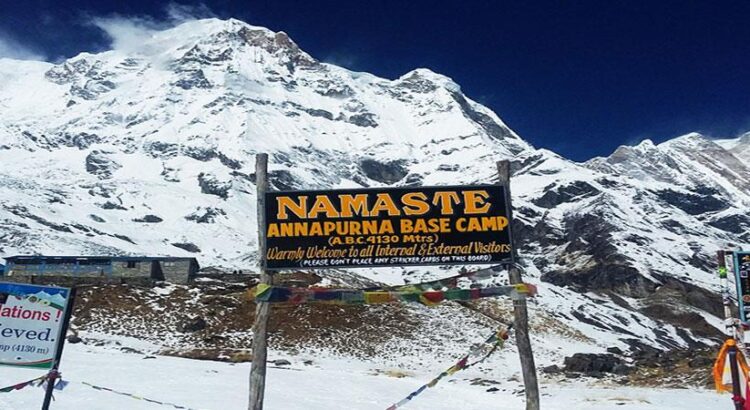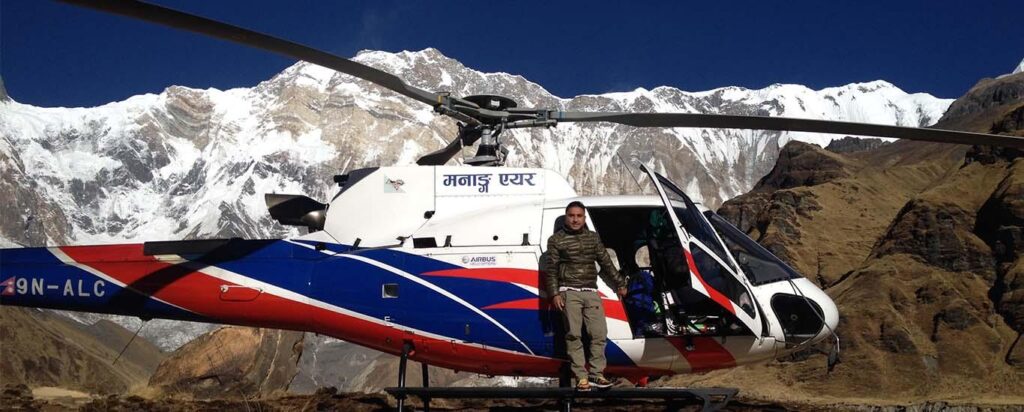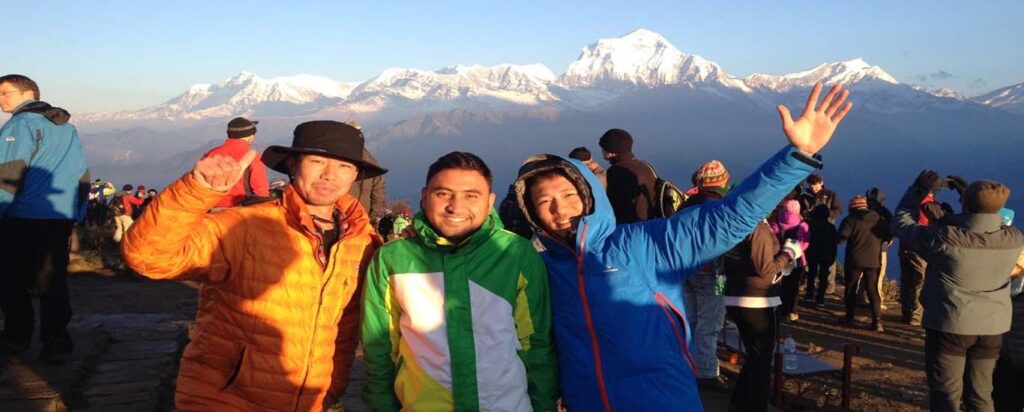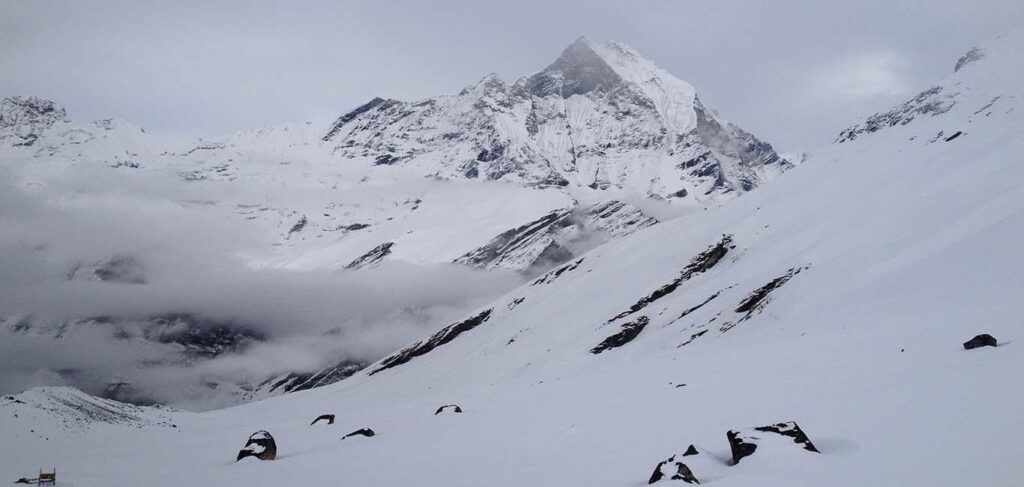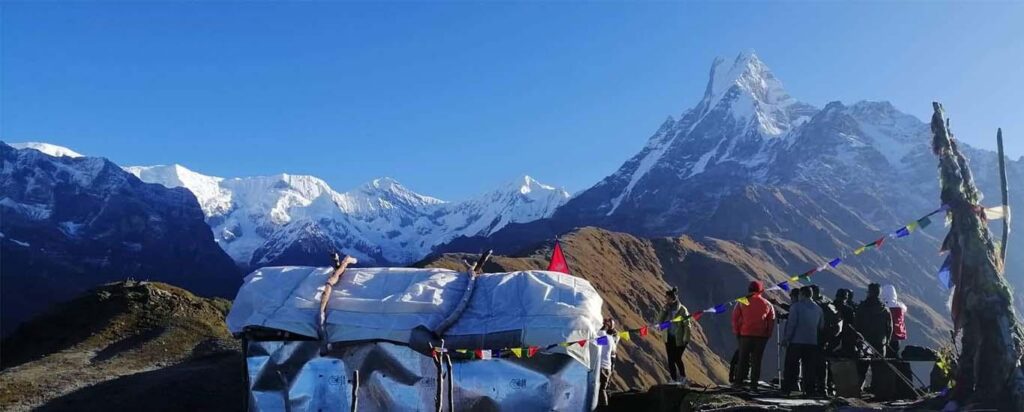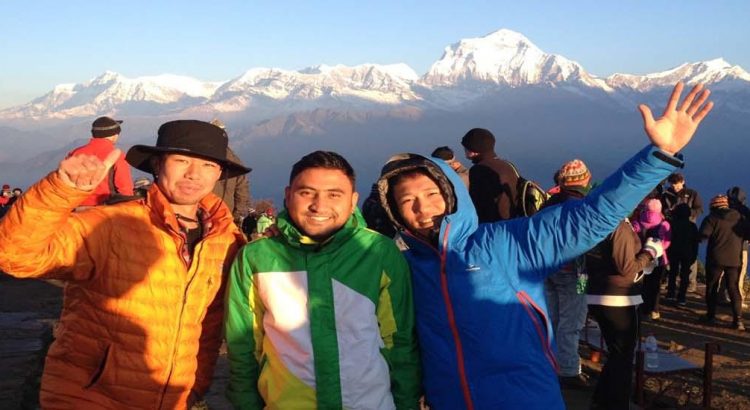Introduction
Start on an unforgettable 9-day Ghorepani Poon Hill Trek, immersing yourself in the natural beauty and cultural wonders of the Annapurna region. Begin your journey with a scenic drive from Pokhara to Nayapul, followed by an exhilarating trek through picturesque villages, lush forests, and rhododendron-filled trails. Witness awe-inspiring sunrise views from Poon Hill, standing at 3,210 meters, and marvel at panoramic vistas of the Annapurna and Dhaulagiri mountain ranges. Explore charming Gurung villages like Ghorepani and Tadapani, experiencing warm hospitality and rich cultural traditions along the way. Conclude your adventure with lasting memories and a newfound appreciation for the Himalayan landscape.
Trip Highlights of Ghorepani Poon Hill Trek
- Spectacular sunrise views from Poon Hill at 3,210 meters
- Scenic trek through lush forests and rhododendron-filled trails
- Charming villages with rich Gurung culture and hospitality
- Panoramic vistas of the Annapurna and Dhaulagiri mountain ranges
- Picturesque landscapes and mountain scenery
- Cultural immersion and interaction with local communities
- Refreshing mountain air and serene ambiance
- Opportunities for photography and capturing stunning Himalayan vistas
- Memorable trekking experience with lasting memories of natural beauty
Ghorepani Poon Hill Trek Itinerary
Day 01: Arrival in TIA Kathmandu, Nepal (1400m)
Day 02: Kathmandu Valley Sightseeing
Day 03: Kathmandu to Pokhara Flight, Drive to Nayapul, Trek to Tikhedhunga (1,540m)
Day 04: Trek from Tikhedhunga to Ghorepani (2,860m), 5-6 hours trek
Day 05: Hike to Poonhill (3,210m) and trek from Ghorepani to Tadapani (2,600m), 6-7 hours trek
Day 06: Trek from Tadapani to Ghandruk (1,950m), 2-3 hours trek
Day 07: Trek from Ghandruk to Nayapul (1,070m) and drive to Pokhara, 3-4 hours trek and 1-2 hour drive
Day 08: Pokhara to Kathmandu Flight or Drive 25-30 minute flight/ 6-7 hour drive
Day 09: Departure from Kathmandu
Why Choose Ghorepani Poon Hill Trek?
The Ghorepani Poon Hill Trek is a popular choice for several reasons:
01. Spectacular Sunrise Views: Witnessing the sunrise from Poon Hill, with panoramic vistas of the Annapurna and Dhaulagiri mountain ranges, is a highlight of the trek and offers unforgettable scenic beauty.
02. Short Duration: Perfect for those with limited time, the trek can be completed in around 9 days, offering a rewarding Himalayan experience without the need for extensive time commitments.
03. Cultural Immersion: Encounter the rich Gurung culture and hospitality in charming villages along the trekking route, providing opportunities for cultural immersion and authentic experiences.
04. Accessible Difficulty: With moderate difficulty level, the trek is suitable for trekkers of various fitness levels, making it accessible to both novice and experienced hikers.
05. Varied Landscapes: Trek through lush forests, rhododendron-filled trails, and picturesque landscapes, offering diverse and captivating scenery throughout the journey.
06. Photography Opportunities: Capture stunning Himalayan vistas, sunrise views, and vibrant cultural scenes, providing ample opportunities for photography enthusiasts to capture memorable moments.
07. Well-Established Route: The trek follows a well-established route with comfortable tea house accommodations and amenities, ensuring a safe and enjoyable trekking experience.
Overall, the Ghorepani Poon Hill Trek is chosen by many for its combination of breathtaking natural beauty, cultural experiences, accessibility, and manageable duration, making it a rewarding adventure in the heart of the Himalayas.
Why is the Famous Ghorepani Poon Hill Trek?
The Ghorepani Poon Hill Trek is renowned for its stunning sunrise vistas from Poon Hill, offering panoramic views of the Annapurna and Dhaulagiri mountain ranges. This trek’s popularity also stems from its manageable duration of around 9 days, making it accessible to travelers with limited time. Additionally, trekkers are drawn to the opportunity to immerse themselves in the rich Gurung culture of charming villages like Ghorepani and Tadapani along the route. With its moderate difficulty level, diverse landscapes, and well-established trails, the Ghorepani Poon Hill Trek provides an unforgettable Himalayan adventure for adventurers of all levels.
Pokhara to Ghorepani Poon Hill Distance
The distance from Pokhara to Ghorepani, the gateway to the Poon Hill trek, is approximately 42 kilometers (26 miles) as the crow flies. However, trekking routes typically cover a longer distance due to the winding mountain trails and elevation gain. The actual trekking distance from Nayapul (the starting point near Pokhara) to Ghorepani is around 35-40 kilometers (22-25 miles), depending on the specific route taken and any detours along the way. Trekking this distance usually takes around 2 to 3 days, depending on the trekker’s pace and itinerary.
Ghorepani Poon Hill Trekking Route
Pokhara to Nayapul: Start your journey with a scenic drive from Pokhara to Nayapul, the starting point of the trek (approximately 1.5-2 hours).
Nayapul to Tikhedhunga: Trek through picturesque villages like Tikhedhunga, gradually ascending steep stone steps and enjoying glimpses of local life along the way.
Tikhedhunga to Ghorepani: Continue your trek through lush forests and rhododendron groves, ascending to the charming village of Ghorepani, renowned for its panoramic sunrise views from Poon Hill.
Ghorepani to Poon Hill and Tadapani: Rise early for a mesmerizing hike to Poon Hill, where you’ll witness the majestic sunrise over the Annapurna and Dhaulagiri mountain ranges. Afterward, trek to Tadapani through forests and terraced fields, reveling in the tranquility of the Himalayan landscape.
Tadapani to Ghandruk: Descend to the traditional Gurung village of Ghandruk, passing through lush forests and enjoying stunning views of Annapurna South, Hiunchuli, and Machhapuchhre along the way.
Ghandruk to Nayapul and Pokhara: Conclude your trek with a scenic descent to Nayapul, where you’ll bid farewell to the mountains and drive back to Pokhara. Optionally, you can extend your journey with side trips or additional days in the region before returning to Kathmandu.
This route provides a memorable and rewarding trekking experience, offering a perfect blend of natural beauty, cultural immersion, and Himalayan adventure.
Best Season for Ghorepani Poon Hill Trek
The best season for the Ghorepani Poon Hill Trek is generally during the spring (March to May) and autumn (September to November) months. During these seasons, the weather is generally stable, with clear skies, mild temperatures, and less chance of rainfall or snowfall, making for optimal trekking conditions. Additionally, the spring season brings vibrant rhododendron blooms, adding to the beauty of the landscape, while autumn offers stunning views of the Himalayan peaks. These months also coincide with the peak trekking season in Nepal, resulting in better infrastructure, more amenities along the trekking route, and a vibrant atmosphere with fellow trekkers from around the world. However, it’s essential to be prepared for crowds during these peak seasons, and early booking of accommodations and permits is recommended.
Ghorepani Poon Hill Trek Difficulty
The Ghorepani Poon Hill Trek is generally considered to be of moderate difficulty. While it does involve some steep ascents and descents, particularly on the initial days of the trek, the overall terrain is well-established and manageable for trekkers with a reasonable level of fitness. The trek typically does not require any technical climbing skills or equipment, and the daily hiking durations are moderate, allowing for ample rest and acclimatization along the way. However, altitude considerations should not be overlooked, especially when ascending to Poon Hill for sunrise views. Proper acclimatization, pacing, and staying hydrated are essential for a comfortable and enjoyable trekking experience. Overall, with adequate preparation and a positive mindset, the Ghorepani Poon Hill Trek is accessible to a wide range of trekkers, including beginners with some hiking experience.
Transportation Service for Ghorepani Poon Hill Trek
For the Ghorepani Poon Hill Trek, transportation services typically include the following:
Kathmandu to Pokhara: Many trekkers start their journey by traveling from Kathmandu to Pokhara, the gateway to the Annapurna region. Transportation options include:
Tourist buses: These are comfortable and affordable options that take around 6-7 hours to reach Pokhara from Kathmandu.
Domestic flights: For those seeking a quicker option, there are daily flights from Kathmandu to Pokhara, which take around 25-30 minutes.
Pokhara to Nayapul: From Pokhara, trekkers travel to Nayapul, the starting point of the Ghorepani Poon Hill Trek. Transportation options include:
Private or shared vehicles: Taxis, jeeps, or minibusses can be hired from Pokhara to Nayapul, which takes approximately 1.5-2 hours by road.
Return Transportation: After completing the trek, trekkers return from Nayapul to Pokhara and then from Pokhara to Kathmandu using similar transportation options as mentioned above.
Travelers can arrange transportation services through trekking agencies, hotels, or transportation companies in Kathmandu or Pokhara. It’s advisable to book transportation in advance, especially during the peak trekking seasons, to ensure availability and smooth travel arrangements.
Accommodations on Ghorepani Poon Hill Trek
Accommodations on the Ghorepani Poon Hill Trek are primarily provided in tea houses or guesthouses along the trekking route. These accommodations vary in terms of comfort and facilities but generally offer basic amenities such as beds with blankets, shared bathrooms with running water (usually cold), and communal dining areas where meals are served. Some tea houses may also offer hot showers for an additional fee. While the accommodations are basic, they provide a cozy and welcoming environment for trekkers to rest and recharge after a day of hiking. It’s advisable to bring a sleeping bag for added warmth and comfort, especially during the colder months. Additionally, during peak trekking seasons, it’s recommended to book accommodations in advance to ensure availability, especially in popular trekking destinations like Ghorepani.
Meal Facilities during the Ghorepani Poon Hill Trek
During the Ghorepani Poon Hill Trek, meal facilities are available at tea houses or guesthouses along the trekking route. These establishments typically provide hearty and nutritious meals to fuel trekkers for their journey.
Breakfast: A typical breakfast at tea houses includes options such as Tibetan bread, pancakes, porridge, eggs (fried, boiled, or omelet), muesli, and toast, accompanied by tea or coffee.
Lunch: Lunch options often consist of dal bhat (rice with lentil soup and vegetables), noodle soup (such as thukpa or ramen), fried rice, fried noodles, or sandwiches.
Dinner: Dinner menus typically offer similar options to lunch, with dal bhat being a staple choice. Other common dishes include pasta, pizza, momos (dumplings), curry with rice or chapati, and yak steak (in some areas).
Most tea houses also serve a variety of hot and cold beverages, including tea, coffee, hot chocolate, and soft drinks. Snacks such as biscuits, chocolate bars, and energy bars are also available for purchase.
It’s essential to note that menu options may vary between tea houses, and prices may be slightly higher at higher altitudes due to transportation costs. Additionally, vegetarian and vegan options are generally readily available, but it’s advisable to inform the tea house staff of any dietary preferences or restrictions in advance.
Guides and Porters for Ghorepani Poon Hill Trek
The cost of hiring guides and porters for the Ghorepani Poon Hill Trek can vary depending on several factors, including the duration of the trek, the services provided, and the negotiation skills of the trekker. However, here are approximate price ranges based on current market rates:
Guides:
Daily rate: $20 to $30 per day
This rate usually includes the guide’s fee, accommodation, meals, and insurance.
Additional expenses such as tips are at the discretion of the trekker.
Porters:
Daily rate: $15 to $25 per day
This rate typically includes the porter’s fee, accommodation, meals, and insurance.
Porters usually carry up to 15-20 kg of trekking gear per person.
It’s essential to clarify the terms of the agreement with guides and porters before the trek, including their responsibilities, accommodation arrangements, and any additional costs. Trekking agencies in Kathmandu or Pokhara can help arrange guides and porters at competitive rates and ensure that they are properly trained and equipped for the trek. Additionally, trekkers should consider the ethical treatment and fair compensation of guides and porters when negotiating prices.
Route Permits for Ghorepani Poon Hill Trek
For the Ghorepani Poon Hill Trek, several permits are required to ensure legal access to the trekking routes and conservation areas. These permits include:
TIMS (Trekkers’ Information Management System) Card:
The TIMS card is mandatory for all trekkers in Nepal and helps authorities keep track of tourists trekking in the region.
It can be obtained through registered trekking agencies in Kathmandu or Pokhara or directly from the Nepal Tourism Board office.
ACAP (Annapurna Conservation Area Permit):
The ACAP permit is required for trekking in the Annapurna Conservation Area, which includes the Ghorepani Poon Hill Trek route.
It can be obtained at the entrance gate of the conservation area or through registered trekking agencies in Kathmandu or Pokhara.
Local Entry Permit:
Some areas along the trekking route may require a local entry permit, which can usually be obtained at the respective entry points or checkpoints.
The requirement for this permit and its cost may vary depending on the specific route and local regulations.
It’s essential for trekkers to carry these permits with them at all times during the trek, as authorities may check for permits at various checkpoints along the route. Trekking agencies can assist in obtaining these permits and ensure that all necessary paperwork is in order before starting the trek. Additionally, trekkers should be aware of permit fees and any associated regulations to ensure compliance with local laws and conservation efforts.
Ghorepani Poon Hill Trek Cost
The cost of the Ghorepani Poon Hill Trek can vary depending on several factors, including the duration of the trek, the services included, the season, and individual preferences. Here’s a general breakdown of potential expenses:
Cost for Permits:
TIMS Card: Approximately $20-$30 per person.
ACAP Permit: Approximately $30-$40 per person.
Local Entry Permits (if required): Varies depending on the specific route and local regulations.
Cost for Transportation:
Kathmandu to Pokhara (round trip): $20-$30 per person by tourist bus, or $100-$150 per person by domestic flight.
Pokhara to Nayapul (round trip): $20-$30 per person by private/shared vehicle.
Cost for Accommodation:
Tea house accommodations: $5-$20 per night per person, depending on the quality of the facilities and services.
Accommodation in Pokhara or Kathmandu before and after the trek: Varies depending on the type of accommodation chosen.
Cost for Food and Drinks:
Meals at tea houses: $5-$15 per meal per person, depending on the menu and location.
Snacks and beverages: Additional costs for snacks, bottled water, soft drinks, and alcoholic beverages.
Cost for Guide and Porter Fees (Optional):
Guide: $20-$30 per day.
Porter: $15-$25 per day.
Tips for guides and porters: Customary, but not mandatory; typically around 10% of the total trekking cost.
Cost for Other Expenses:
Trekking gear rental/purchase: Costs vary depending on the items needed.
Travel insurance: Recommended to cover emergency medical expenses, evacuation, and trip cancellation/interruption.
Overall, the total cost of the Ghorepani Poon Hill Trek can range from $300 to $1000 or more per person, depending on the level of comfort, services, and additional activities chosen. It’s essential to budget accordingly and consider all potential expenses when planning for the trek.
Tips for a Successful Ghorepani Poon Hill Trek
Here are some tips for a successful Ghorepani Poon Hill Trek:
01. Plan Ahead: Research the trekking route, required permits, and weather conditions before your trip. Have a detailed itinerary and backup plans in case of unforeseen circumstances.
02. Train and Prepare: Build up your physical fitness and endurance through regular exercise and hiking. Practice walking with a backpack to get used to carrying your gear.
03. Pack Wisely: Pack lightweight, moisture-wicking clothing suitable for both warm and cold weather. Essentials include sturdy hiking boots, a warm sleeping bag, waterproof jacket, sunscreen, and a first aid kit.
04. Stay Hydrated and Nourished: Drink plenty of water to stay hydrated and eat regular meals to maintain energy levels during the trek. Carry water purification tablets or a filtration system for safe drinking water.
05. Acclimatize Safely: Ascend gradually to higher altitudes to allow your body to acclimatize properly. Take rest days as needed and listen to your body’s signals to avoid altitude sickness.
06. Respect Local Customs: Be respectful of local customs, traditions, and wildlife. Dispose of waste properly and minimize your environmental impact by practicing Leave No Trace principles.
07. Stay Safe: Follow safety guidelines and trekking regulations, stick to designated trails, and avoid trekking alone. Consider hiring a licensed guide or porter for added support and local knowledge.
08. Enjoy the Journey: Take time to appreciate the stunning scenery, interact with locals, and embrace the challenges and rewards of the trek. Stay flexible and open-minded, and remember to have fun and enjoy the experience.
09. Monitor Weather Conditions: Keep an eye on the weather forecast and be prepared for sudden changes. Carry appropriate gear such as rain gear and extra layers to stay warm and dry.
10. Start Early: Begin your trek early in the morning to take advantage of cooler temperatures and clearer views. Starting early also allows for more time to reach your destination and avoid trekking during the hottest part of the day.
11. Listen to Your Body: Pay attention to signs of fatigue, dehydration, or altitude sickness, and adjust your pace or rest as needed. Prioritize your well-being throughout the trek.
12. Stay Connected: Inform someone about your trekking plans and check in regularly if possible, especially at checkpoints along the trail.
13. Respect Wildlife: Keep a safe distance from wildlife and avoid feeding or disturbing animals along the route. Leave no trace and minimize your impact on the natural environment.
14. Celebrate Your Achievement: Reach Ghorepani Poon Hill with a sense of accomplishment and gratitude. Take time to savor the moment and reflect on your experiences during the trek.
By following these tips, you can ensure a safe, enjoyable, and memorable Ghorepani Poon Hill Trek experience.
Altitude Sickness Prevention Tips for Ghorepani Poon Hill Trek
Altitude sickness, also known as acute mountain sickness (AMS), can affect trekkers ascending to higher elevations, including those on the Ghorepani Poon Hill Trek. Here are some altitude sickness prevention tips:
01. Ascend Gradually: Ascend slowly to allow your body time to acclimatize to higher altitudes. Avoid gaining more than 300-500 meters in elevation per day above 2,500 meters.
02. Stay Hydrated: Drink plenty of water to stay hydrated, as dehydration can exacerbate altitude sickness symptoms. Aim to drink at least 3-4 liters of water per day.
03. Include Acclimatization Days: Incorporate rest days into your itinerary to allow for acclimatization. Spend an extra day at higher elevations to help your body adjust before continuing your ascent.
04. Recognize Symptoms: Be aware of the symptoms of altitude sickness, which may include headache, nausea, dizziness, fatigue, and difficulty sleeping. Inform your guide or fellow trekkers if you experience any of these symptoms.
05. Medication: Consider carrying altitude sickness medication such as acetazolamide (Diamox) as a preventive measure. Consult with a healthcare professional before taking any medication and familiarize yourself with potential side effects.
06. Maintain a Balanced Diet: Eat regular, nutritious meals to fuel your body and maintain energy levels during the trek. Include carbohydrates for energy and foods rich in potassium and magnesium to help prevent muscle cramps.
07. Avoid Alcohol and Tobacco: Avoid alcohol and tobacco products, as they can worsen altitude sickness symptoms and impair oxygen uptake at higher elevations.
08. Stay Warm: Dress in layers to stay warm and protect yourself from the cold. Proper clothing can help prevent hypothermia, which can exacerbate altitude sickness.
09. Descend if Necessary: If you experience severe symptoms of altitude sickness, descend to a lower elevation immediately. Do not continue ascending until your symptoms have resolved.
10. Listen to Your Body: Pay attention to your body’s signals and take breaks as needed. Do not push yourself too hard, and communicate openly with your guide about how you are feeling.
By following these altitude sickness prevention tips and taking proper precautions, you can minimize the risk of experiencing altitude-related issues and enjoy a safe and rewarding trek on the Ghorepani Poon Hill route.
Similar Trekking Packages of Ghorepani Poon Hill Trek
Several trekking packages in Nepal offer similar experiences to the Ghorepani Poon Hill Trek, combining stunning mountain views, cultural encounters, and moderate trekking routes. Some of these similar trekking packages include:
Mardi Himal Trek
The Mardi Himal Trek takes trekkers through pristine forests, rhododendron groves, and high alpine meadows to the base camp of Mardi Himal. This trek offers close-up views of the Annapurna and Machhapuchhre peaks and is less crowded than other popular treks in the region.

Langtang Valley Trek
The Langtang Valley Trek explores the Langtang National Park, home to diverse flora and fauna, including red pandas and Himalayan thars. Trekkers can enjoy panoramic mountain views, visit Tibetan-influenced villages, and trek through lush forests and alpine meadows.

Everest Short Trek
Our 07 Day Everest Short Trek is the gentler cousin of our standard Everest Base Camp Trek. Although the trek only leads up to Khumjung or Tengboche at most, the mesmerizing views of some of the highest peaks in the world with the touch of Sherpa culture and lifestyle is still an exhilarating experience. This trek is also popularly known as the Everest View Trek or Everest Panorama Trekking.

These trekking packages provide similar experiences to the Ghorepani Poon Hill Trek, with varying durations, difficulty levels, and highlights. Trekkers can choose the trek that best suits their preferences, time constraints, and fitness levels to enjoy an unforgettable adventure in the Himalayas of Nepal.
Ghorepani Poon Hill Trek FAQ(s)
01. How difficult is the Ghorepani Poon Hill Trek?
The Ghorepani Poon Hill Trek is considered a moderate trek, suitable for trekkers of all experience levels. The trails are well-maintained, and the daily hiking durations are manageable for most people.
02. What is the best time of year to do the Ghorepani Poon Hill Trek?
The best time to do the Ghorepani Poon Hill Trek is during the spring (March to May) and autumn (September to November) seasons when the weather is clear, and the skies are usually sunny. These months offer the best visibility for mountain views.
03. Do I need a guide or porter for the Ghorepani Poon Hill Trek?
While it’s not mandatory to hire a guide or porter for the Ghorepani Poon Hill Trek, many trekkers choose to do so for added support, local knowledge, and convenience. Guides and porters can enhance the trekking experience and assist with navigation, accommodation, and logistics.
04. How long does the Ghorepani Poon Hill Trek take?
The standard Ghorepani Poon Hill Trek typically takes around 4 to 5 days to complete, depending on the specific itinerary and trekking pace. However, variations in duration are possible, including shorter or longer itineraries.
05. What permits do I need for the Ghorepani Poon Hill Trek?
Trekkers need to obtain the TIMS (Trekkers’ Information Management System) card and the ACAP (Annapurna Conservation Area Permit) for the Ghorepani Poon Hill Trek. These permits can be obtained from the Nepal Tourism Board office or through registered trekking agencies.
06. Are there accommodation and food options along the Ghorepani Poon Hill Trek?
Yes, there are plenty of tea houses and lodges along the Ghorepani Poon Hill Trek route, offering basic accommodation and meals such as dal bhat (rice and lentils), noodles, soups, and tea. Trekkers should expect simple but comfortable facilities.
07. Is altitude sickness a concern on the Ghorepani Poon Hill Trek?
Altitude sickness is generally not a concern on the Ghorepani Poon Hill Trek, as the maximum altitude reached is around 3,210 meters at Poon Hill. However, trekkers should still be mindful of their health and acclimatize properly.
08. What should I pack for the Ghorepani Poon Hill Trek?
Essential items to pack for the Ghorepani Poon Hill Trek include sturdy hiking boots, appropriate clothing layers, a warm sleeping bag, sunscreen, a first aid kit, and personal toiletries. It’s also important to carry enough water and snacks for the trek.
09. Are there ATMs or internet access along the Ghorepani Poon Hill Trek route?
ATM and internet access may be limited along the Ghorepani Poon Hill Trek route, especially in remote areas. Trekkers are advised to carry enough cash for their trekking expenses and to inform family and friends of potential communication challenges.
10. Can I customize my Ghorepani Poon Hill Trek itinerary?
Yes, trekking agencies and guides offer customizable Ghorepani Poon Hill Trek itineraries to suit individual preferences, time constraints, and fitness levels. Trekkers can discuss their requirements and preferences with their chosen trekking agency or guide to create a tailored itinerary.
Conclusion
The Ghorepani Poon Hill Trek offers a remarkable journey through the stunning landscapes and cultural riches of the Annapurna region in Nepal. With panoramic mountain views, charming villages, and diverse flora and fauna, this trek is a favorite among trekkers of all levels. Whether you’re seeking adventure, cultural immersion, or simply a break from the hustle and bustle of everyday life, the Ghorepani Poon Hill Trek promises an unforgettable experience. By following proper planning, preparation, and safety measures, trekkers can embark on this journey with confidence and create memories to last a lifetime. So, lace up your boots, breathe in the fresh mountain air, and set out on the adventure of a lifetime in the majestic Himalayas of Nepal.




29.jpg)
